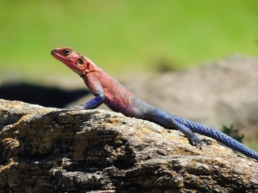The Conservancy Concept is predicated on some simple dynamics. Conservancies are usually contiguous to the national parks and reserves and the wildlife moves freely between both areas. They are different to national reserves, or national parks in that they are not government run and when done properly, they create a win-win-win for wildlife, the local community and tourists.
By working closely with communities living alongside national parks and wildlife reserves, community land is set aside for wildlife so that it can be used for low impact sustainable ecotourism. Land that is often overgrazed is soon restored to its natural state and this leads to increased wildlife numbers and the creation of vital dispersal areas outside the national parks.
I almost always recommend some conservancy days as part of a safari and this is why:
- Controlled visitor numbers: The camps in the conservancies are small and intimate. This leads to lower density. For example, in many of the Mara Conservancies the density is one tent to 700 acres of protected land. All this is better for you and the wildlife – no minivan circus with vehicles jostling for position and crowding the wildlife.
- Great wildlife experience: Since visitor numbers are controlled, game drives can go off-road. It’s quite frustrating when there’s wildlife you want to see that may be some distance from the roads and you simply can’t get close to it or are blocked by other vehicles. In contrast, the conservancy protocols are strong, and you will not have more than five safari vehicles close up on a sighting as vehicles hang back and wait their turn as they know there’s no rush.
- Flexibility: Most of the camps that I recommend are very flexible and you can usually plan your day as you please. Unlike the national reserve there are no curfews – so if you are watching a pride of lions about to set up a hunt you can stay with them, without the restriction of having to return to your camp by sunset. You can also do night drives, game walks, bush breakfasts and lunches. Moreover, most itineraries in the Mara Conservancies offer trips to the National Reserve which I often recommend for river crossings during the migration and to see those big crocodiles.
- Benefits to the local community: Conservancy land is usually owned by the local community – the tourism partners that manage camps pay them rent and also employ them. Some also have special health, water and education schemes for the community.
- Accommodation Options: The conservancies offer a range of accommodation options, from luxury tented camps to more budget-friendly adventure camps. The camps are not usually as cheap as those you can find in the National Reserves or outside the conservancies but with the recent increase in fees to enter the national parks the conservancies are now looking very price competitive.
In 2012 I carried a proof-of-concept evaluation (linked below) at the Ol Kinyei Conservancy which was the first of the Mara Conservancies. Since then, the number and size of the conservancies have increased significantly.
The proposition tested was that Conservancies lead to a “win-win-win” situation by making significant contributions towards wildlife conservation, preventing habitat destruction, increasing eco-tourism and economic activity. This in turn benefits local communities.
A critical imperative for the theory of change is increased wildlife numbers and this was the key focus of the field research. My research proved that wildlife numbers were significantly higher in the established conservancy areas when compared to inherently similar and adjacent habitats where the conservancy was not established. Habitat is restored and increased wildlife and a special visitor experience leads to increased ecotourism and the evidence of the research, through conversations with locals, showed that the success of eco-tourism has tangible benefits to the local community.
There has been concern in certain quarters that the word “conservancy” is seen as controversial by those who have associated it with land grabbing and not being of real benefit to local communities. As with most initiatives, there are good and bad examples, and it is recognised that in some limited cases, the models have not been well designed and implemented. In these cases, they have not delivered on the expected outcomes and some of the impact has been negative. This is not the case with the conservancies I recommend and it would be harmful if those who are concerned about the future of wildlife, wild places and local communities allow successful and proven models to be tarred with the same brush! In the case of the Mara Conservancies, habitat restoration, the increase in wildlife numbers and the return of species to areas that were abandoned by them; together with the increase in ecotourism and the demonstrable benefits to the local community has been critical in delivering the win-win-win situation discussed earlier.
It is important to emphasise that the land laws mean that community individuals are empowered to decide whether they want their land to be part of the conservancy – they cannot be evicted. The Conservancy model discussed in my report relies on the active involvement of the local communities – they are involved in identifying the area that will be included in the conservancy and become real stakeholders. The fact that the communities themselves want to expand the areas of the conservancies is a testament to the fact that they see it as working for them.









